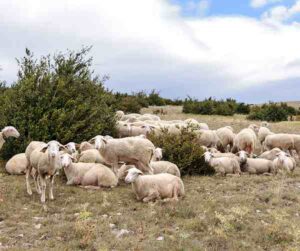The North Ronaldsay sheep is a breed of domestic sheep from Scotland. It is actually from the northernmost island of Orkney, off the north coast of the country.
The breed actually belongs to the Northern European short-tailed sheep group of breeds. The breed was developed pretty easily, without much cross-breeding with modern sheep breeds.
Previously it was mainly used for wool production. But today two largest flocks of this breed are feral. One flock is on the North Ronaldsay and another one is on the Orkney island of Linga Holm.
The North Ronaldsay sheep is pretty rare today, and it is listed as ‘vulnerable‘ on the Rare Breeds Survival Trust list.
And currently there are fewer than 600 registered breeding ewes available in the United Kingdom. Presence of these animals in the North Ronaldsay is not known.
But they probably arrived in that area as early as the Iron Age. And they probably are the earliest ovines to arrive in Britain.
They have developed without much admixture from imported European and Roman breeds, because of their isolated location. However, read some more information about this breed below.
North Ronaldsay Sheep Characteristics
North Ronaldsay sheep are smaller sized animals. They share some characteristics with Scandinavian sheep, including their color range and short tails.
Colors of these animals can vary. And their most common colors are black, brown, grey and white. The rams are usually all horned, and only around 20 percent of the ewes are horned and rest ewes are polled.

Horns of the rams are generally ridged and spiraled. They have relatively short tails. As a smaller sized animal, average height of the rams is around 16 inches. And the ewes are almost of same size as the rams, measuring around 16 inches.
Average live body weight of the mature North Ronaldsay rams is around 30 kg. And the mature rams weight slightly less than the rams. Average live body weight of the mature ewes is around 25 kg. Photo and info from Wikipedia.
Uses
North Ronaldsay sheep is raised for both meat and wool production. They are also good for conservation grazing.
Special Notes
The North Ronaldsay sheep are very hardy and strong animals. They are highly adapted to their local climates. They are good for both meat and wool production.
Previously they were used mainly for meat production. But now also used for meat production. They produce high quality meat.
They are similar to the Shetland sheep breed in color, and full fleece weights around 1 kg. However, review full breed profile of the North Ronaldsay sheep in the following chart.
| Breed Name | North Ronaldsay |
| Other Name | None |
| Breed Purpose | Meat, wool conservation grazing |
| Special Notes | Very hardy and strong animals, highly adapted to local climates, good for both meat and wool production, produce high quality meat |
| Breed Size | Small |
| Weight | 25-30 kg |
| Horns | Yes |
| Climate Tolerance | Native climates |
| Color | Black, brown, grey and white |
| Rarity | Rare |
| Country/Place of Origin | Scotland |






